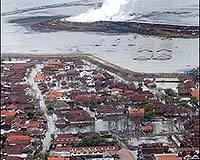| . |  |
. |
Hvolsvoellur, Iceland (AFP) March 21, 2010 Iceland's first volcanic eruption in six years sent lava and ashes into the air, forcing hundreds to flee their homes and halting flights, but caused no damage or casualties. Smoke could be seen rising from behind Eyjafjallajoekull glacier and volcanic ash filled the sky after the eruption that began around midnight on Sunday following three weeks of localised earthquakes. The eruption occurred in a remotely populated area about 125 kilometres (75 miles) east of Iceland's capital Reykjavik and caused 600 people to flee their homes. It also brought to a halt all flights into and out of the Nordic island nation, but they resumed with serious delays mid-day Sunday, while domestic traffic started up again late in the afternoon. The risk of floods posed by melting glacial ice prompted the authorities to declare a state of emergency and to immediately evacuate the area. It was the first volcanic eruption in Iceland since 2004, and the first in the vicinty of Eyjafjallajoekull, in the south of the island, since 1823. "We did not have time to be afraid and everyone was so calm and stoical," said farmer Thorhildur Bjarnadottir, 51, who received the evacuation order by text message on her mobile phone. "We went right away and checked on our neighbours in the nearby farms," she added, explaining meetings had been held during the summer on what to do in case of an eruption. "The worst part in all of this is to leave our animals behind at home," her husband added. Local police chief Kjartan Thorkelsson told AFP the evacuation plan went well, although some farmers reportedly refused to leave their homes. He said almost all area residents, except those living on 14 farms still at risk, were allowed to return home late in the afternoon. "We are allowing almost all of the 600 inhabitants to return to their homes... All roads have now been opened" he said, adding "there is still an official situation of danger because of the volcanic eruption". Significant floods were avoided because the fissure eruption occurred between two large glaciers, Eyjafjallajoekull and Myrdalsjoekull, said Magnus Tumi Gudmundsson, a professor of geophysics and civil protection advisor. "We are extremely lucky that the eruption did not occur underneath the glacier, so therefore a gigantic glacier flood did not occur," Gudmundsson said. With about 15 magma exits at the fissure, he said, and the volcano "is not a big eruption" by Icelandic standards. But Gudmundsson warned that extreme caution had to be exercised, because the eruption was taking place so close to two large glaciers. "The eruption could end within one or two days, but also within one or two years," he told reporters. Thorkelsson said no damages related to the eruption had been reported. "There is almost no measureable quantity of volcanic ash that fell to the ground," he said. Following eruptions, volcanic ash often falls to the ground, damaging vehicules. The Red Cross set up an emergency telephone line and opened three evacuation centres in the towns of Hella, Hvolsvoellur and Vik to help people displaced by the eruption. Bjoerk Valdimarsdottir, whose sister lives in the vicinity of the eruption, told Swedish news website dn.se the glow from the eruption could be seen near the capital, where she lives. "There are lots of people who want to go there to take a look and that's why they closed the road some miles out of Reykjavik," she said. Asked by Swedish public radio if she felt there was any danger, local resident Christina Bengtsson said the biggest problem was volcanic ash. "The ash can be dangerous for the animals," she said. "When we went out before, we could feel (the ash) in our mouths. From my window, I see a red sky. If I went out the door, I could also see fire."
Share This Article With Planet Earth
Related Links Bringing Order To A World Of Disasters When the Earth Quakes A world of storm and tempest
 Link Between Exploration Well And Lusi Mud Volcano
Link Between Exploration Well And Lusi Mud VolcanoBerkeley CA (SPX) Feb 17, 2010 New data provides the strongest evidence to date that the world's biggest mud volcano, which killed 13 people in 2006 and displaced thirty thousand people in East Java, Indonesia, was not caused by an earthquake, according to an international scientific team that includes researchers from Durham University and the University of California, Berkeley. Drilling firm Lapindo Brantas has denied ... read more |
|
| The content herein, unless otherwise known to be public domain, are Copyright 1995-2010 - SpaceDaily. AFP and UPI Wire Stories are copyright Agence France-Presse and United Press International. ESA Portal Reports are copyright European Space Agency. All NASA sourced material is public domain. Additional copyrights may apply in whole or part to other bona fide parties. Advertising does not imply endorsement,agreement or approval of any opinions, statements or information provided by SpaceDaily on any Web page published or hosted by SpaceDaily. Privacy Statement |